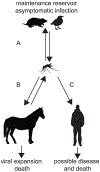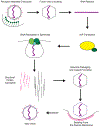The life cycle of the alphaviruses: From an antiviral perspective
- PMID: 36436722
- PMCID: PMC9840710
- DOI: 10.1016/j.antiviral.2022.105476
The life cycle of the alphaviruses: From an antiviral perspective
Abstract
The alphaviruses are a widely distributed group of positive-sense, single stranded, RNA viruses. These viruses are largely arthropod-borne and can be found on all populated continents. These viruses cause significant human disease, and recently have begun to spread into new populations, such as the expansion of Chikungunya virus into southern Europe and the Caribbean, where it has established itself as endemic. The study of alphaviruses is an active and expanding field, due to their impacts on human health, their effects on agriculture, and the threat that some pose as potential agents of biological warfare and terrorism. In this systematic review we will summarize both historic knowledge in the field as well as recently published data that has potential to shift current theories in how alphaviruses are able to function. This review is comprehensive, covering all parts of the alphaviral life cycle as well as a brief overview of their pathology and the current state of research in regards to vaccines and therapeutics for alphaviral disease.
Keywords: Positive-sense RNA viruses; Viral life cycle; Viral replication; alphaviruses.
Copyright © 2022 The Authors. Published by Elsevier B.V. All rights reserved.
Conflict of interest statement
Declaration of competing interest The authors declare that they have no known competing financial interests or personal relationships that could have appeared to influence the work reported in this paper.
Figures



References
-
- International Committee on Taxonomy of Viruses. Taxonomy. (2020).
-
- Crosby L. et al. Severe manifestations of chikungunya virus in critically ill patients during the 2013–2014 Caribbean outbreak. Int. J. Infect. Dis 48, 78–80 (2016). - PubMed
-
- Rezza G. et al. Infection with chikungunya virus in Italy: an outbreak in a temperate region. The Lancet 370, 1840–1846 (2007). - PubMed
Publication types
MeSH terms
Substances
Grants and funding
LinkOut - more resources
Full Text Sources
Medical

